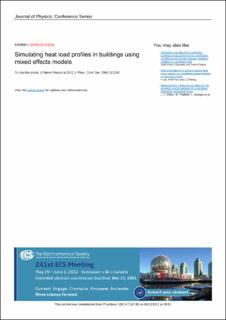| dc.contributor.author | Palmer Real, J. | |
| dc.contributor.author | Kloppenborg Møller, J. | |
| dc.contributor.author | Rasmussen, C. | |
| dc.contributor.author | Lindberg, Karen Byskov | |
| dc.contributor.author | Sartori, Igor | |
| dc.contributor.author | Madsen, H. | |
| dc.date.accessioned | 2021-12-09T07:57:51Z | |
| dc.date.available | 2021-12-09T07:57:51Z | |
| dc.date.created | 2021-12-08T06:58:21Z | |
| dc.date.issued | 2021 | |
| dc.identifier.issn | 1742-6588 | |
| dc.identifier.uri | https://hdl.handle.net/11250/2833485 | |
| dc.description.abstract | The landscape of buildings is a diverse one and long-term energy system planning requires simulation tools that can capture such diversity. This work proposes a model for simulating the space-heating consumption of buildings using a linear mixed-effects model. This modelling framework captures the noise caused by the differences that are not being measured between individual buildings; e.g. the preferences of their occupants. The proposed model uses outdoor temperature and space-heating consumption measured at hourly resolution; thus, the model is able to predict the intra-day variations as well as longer effects. Given the stochastic nature of the simulation, the prediction interval of the simulation can be estimated, which defines a region where the consumption of any unobserved building will fall in. A whole year has been simulated and compared to out-of-sample measurements from the same period. The results show that the out-of-sample data is virtually always inside the estimated 90% prediction interval. This work uses data from Norwegian schools, although the model is general and can be built for other building categories. This amount of detail allows energy planners to draw a varied and realistic map of the future energy needs for a given location. | en_US |
| dc.language.iso | eng | en_US |
| dc.publisher | IOP Publishing | |
| dc.rights | CC BY 3.0 | * |
| dc.rights.uri | https://creativecommons.org/licenses/by/3.0/ | * |
| dc.title | Simulating heat load profiles in buildings using mixed effects models | en_US |
| dc.type | Peer reviewed | en_US |
| dc.type | Journal article | en_US |
| dc.description.version | publishedVersion | en_US |
| dc.rights.holder | © 2021 The authors | en_US |
| dc.subject.nsi | VDP::Teknologi: 500 | en_US |
| dc.source.volume | 2069 | en_US |
| dc.source.journal | Journal of Physics: Conference Series (JPCS) | en_US |
| dc.identifier.doi | 10.1088/1742-6596/2069/1/012138 | |
| dc.identifier.cristin | 1965878 | |
| dc.relation.project | Norges forskningsråd: 294920 | en_US |
| dc.source.articlenumber | 012138 | en_US |
| cristin.ispublished | true | |
| cristin.fulltext | original | |
| cristin.qualitycode | 1 | |

